QUESTIONS
SECTION A (40 marks)
Answer all the questions in this section in the spaces provided.
-
- State two reasons for undertaking building construction as a course. (2 marks)
- List three hindrances one may encounter when starting a construction business. (3 marks)
-
- State two ways of storing tins of oil paints on a construction site. (2 marks)
- Give two reasons for the type of storage in 2(a). (2 marks)
-
- State four positions that require damp proofing in a domestic building. (2 marks)
- Name four types of damp proofing materials. (2 marks)
-
- State two advantages and two disadvantages of using a site square for setting out (2 marks)
- Give four methods of curing vertical in-situ cast concrete units. (2 marks)
- Sketch a strip foundation and mark the following on it: (5 marks)
- the position of the dpc showing the mandatory dimensions
- the mandatory Kenya Building Code requirements and show the dimensions of each if the foundation wall thickness is 150mm
- Figure 1 shows parts of an arch opening.
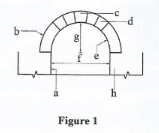
Name the parts labelled a, b, c, d, e, f, gand h (4 marks) - Set three regulations governing the erection of standards in scaffolding works (3 marks)
-
- Sketch and label an angular valley tile (3 marks)
- Explain the term "binders" as used in roof work. (2 marks)
- List three qualities of a good sanitary appliance. (3 marks)
- Sketch the following wall joint finishes.
- Werther pointing
- Tuck painting
SECTION B (60 marks)
Answer question II on the A3 paper provided and any other three questions from this section in the spaces proded. Candidates are advised not to spend more than 25 minutes on question 11.
- Figure 2 shows three views of a hollow wooden block drawn in third angle projection. Draw the block Full Size in isometric projection. (15 marks)
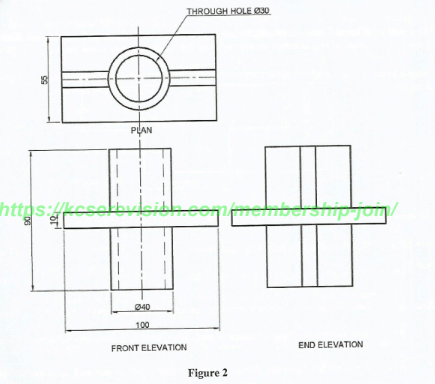
-
- Explain four methods of controlling termites on a construction site without using chemicals.
(8 marks) - Using sketches, explain the difference between hollow blocks and cellular blocks.
(7 marks)
- Explain four methods of controlling termites on a construction site without using chemicals.
-
- State five safety precautions to be taken when using hand tools to dig excavations in trenches (5 marks)
- Explain three properties of coarse aggregates used in construction. (6 marks)
- Use a labelled sectional elevation sketch to show the bonding details at the end of a reinforcement bar in a concrete lintel. (4 marks)
-
- Figure 3 shows a one brick thick wall with an attached pier in English bond. Sketch the plans of two altemate courses to show the bonding details at the pier. (6 marks)
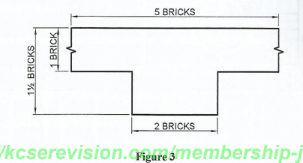
- Sketch and label a deep strip foundation. (4 marks)
- Outline the procedure of fixing wall tiles. (5 marks)
- Figure 3 shows a one brick thick wall with an attached pier in English bond. Sketch the plans of two altemate courses to show the bonding details at the pier. (6 marks)
-
- Describe the term "oversite concrete" as used in building works. (3 marks)
- State three advantages of mastic asphalt when used as a damp proof course. (3 marks)
- Use a labelled isometric sketch to show a honey comb sleeper wall up to the wall plate. (9 marks)
MARKING SCHEME
-
- Reasons for undertaking building construction as a course:
- To build a career
- To understand how to constract a building unit
- To ensure cost efficiency when constructing a buildi
- To be aware of the environmental impact situations when site clearing in order to set out a building.
any 2x12 marks (5 marks)
- Three hindrances one may encounter when starting a business in construction
- Stiff competition
- Corruption within the industry particularly during the tendering process
- Established cartels gauging up against new entrants
- High cost of machinery and equipment required
- Lack of prompt payment or release of funds in time.
- Failure to pay within the contract period
- Iack of adequate capital
any 3x3 marks
- Reasons for undertaking building construction as a course:
-
- Ways of storing tims of all paint on site
- Store on racks above ground level
- Store in cabinets locked in a secluded area with controlled
movement. - Store away from where they can easily catch fir
- Reasons:
- To avoid theft of paint
- To avoid them catching fire incase of carelessness of personnel using the store
- If placed on the ground, its shelf life will be reduced due to low temperatures experienced at the floor level
- Ways of storing tims of all paint on site
-
- Positions where damp-proofing is equired in a domestic building:
- on the ground floor sla
- on the sleeper walls
- on the ground floor wall
- below window sills
- on parapet walls below copings
- on chimney stacks
- in places where the floor level is below the ground level
Any 4x1/2-2 marks (2 marks)
- Types of rigid damp proofing materials
- Engineering bricks
- Slates
- Mastic asphalt
- Sheets of lead, copper etc
- Positions where damp-proofing is equired in a domestic building:
-
- Advantages of using a site square in setting out
- It Can be used for large buildings
- It is faster and easier to use compared to other methods
- It is easy and cheap to construct on site
Disadvantages of using a site square in setting out - Range of accuracy is limited
- The distance cannot be read off on the instrument directly and tape measure must be used
- Methods of curing vertical concrete units
- Covering with gunny bags/ polythene sheets.
- Covering with hessian material
- Keeping under controlled temperature
- Sprinkling water
- Advantages of using a site square in setting out
- Sketch of a strip foundation.

- The parts of the area labelled are as follows:
a-Reveal b- Extrados c-Key brick/crown
d-Voussoirs e-Intrados f-Spam
g- Rise h-Abutment
(5 marks) - Regulations governing the erection of standards in scaffolding work
- Standards of a scaffold must either be vertical or lean slightly towards the building for stability
- If made of steel, the standards, couplers and any joining material should free from corrosion or any other defects.
- Standards mast stand on a firm base off the ground and s on the base plate to prevent slipping or sinking
- The distance between standards must be kept parallel from the top to the bottom
- Maintain equal distance from the wall in all cases.
-
- Angular valley tile
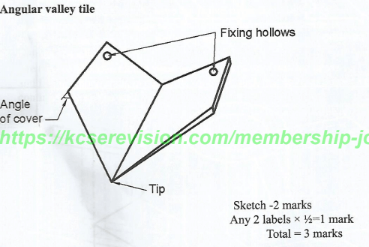
- Binders as used in roof construction
Binders are beams used to give support to ceiling joist and counteract excessive deflections.
- Angular valley tile
- Qualities of a good sanitary appliance
- Easy to clean
- Durability
- Aesthetics
- Hard thus withstands wear
-
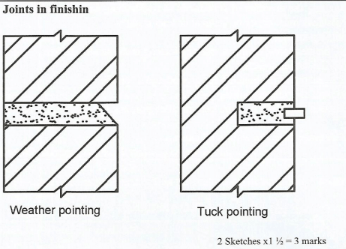
-
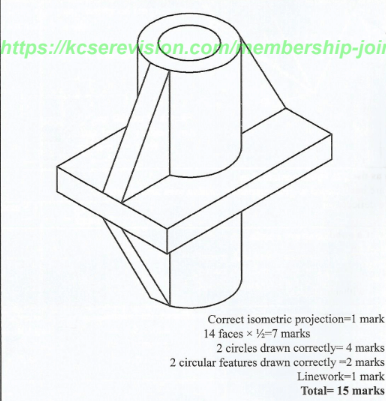
-
- Methods of controlling termites on a construction site apart from the use of chemical spraying are:
- Destroying the habitat
- Clear site of all wooden materials such as tree roots, stumps, dead weeds, grass or contractor's rubbish; which attract termites.
- Use of concrete hase piers to support timber
- Clear the site of any debris from the left over pieces or from previous structures found on site.
- Remove heaps of earth around structural members
-
- Hollow blocks
These type of blocks which have voids that make them lighter in construction. The holes may also be useful when running wiring or piping through them. - Cellular blocks
Are type of blocks which is used with the purpose of sealing gaps and filling ribbed slabs in construction block such tha cavities do not run continuously up the wall.
- Hollow blocks
- Methods of controlling termites on a construction site apart from the use of chemical spraying are:
-
- Safety precautions to be taken when using hand tools for trench excavations.
- Workers to dig at least 10 metres apart from each other.
- The digging tools should be properly fastened to avoid them from flying loose and hurting the other workers
- If possible workers to start digging from opposite directions in order to maintain safe working distances.
- Proper safety attire eg. helmets, boots and other safe clothing to be worn at all times.
- No heavy equipment or machinery should be used next to the trench excavation.
- Trench excavation should be well secured and labelled.
- Three properties of coarse aggregates
- Durability
The coarse aggregates should be durable to last longer and take the loading without any failure. When compressed the course aggregates should not break easily when under pressure. The aggregates should sustain the required load when required. - Shape
One of the major shape of coarse aggregates is to sustain an angular shape. This shape allows for the filling in of fine aggregates and th binding agent in order to attain the required strength. - Strength
When a mix from coarse aggregates is produced, the expected outcome is based on the material strength. This is generated together with proper mixing and use of proper ingredients. Correct strength of concrete mix is achieved by using the correct aggregate sizes and correct quantity measurement.
Accept cleanliness, and density if explained 3x2
- Durability
-
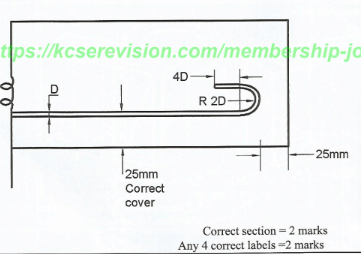
- Safety precautions to be taken when using hand tools for trench excavations.
-
- Alternative plan courses in English board
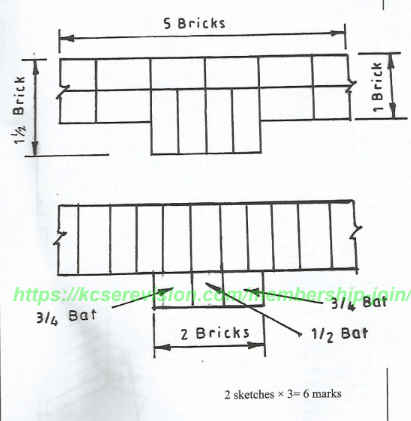
- Deep strip foundation

- Procedure of fixing wall tiles on a newly plaste ed wall
- Sprinkle water on the wall
- Mark the position to place the wall tiles
- Mix cement grout
- Soak the tiles in water
- Apply cement grout on the tile and start laying them on the wall from bottom to top
- Maintain plambness and check levelness as well
- Use tile spacers to maintain uniform joints.
- Clean the tiles immediately to keep the tiles neat and tidy.
- Finish with the required colour grout
- Alternative plan courses in English board
-
- Oversite concrete
- Is a slab made of concrete laid on to the compacted hard core to form a floor base on which a finish is lai
- The building regulations require that it should NOT be less than 100 mm thick.
- Advantages of mastic asphalt when used as d.p.c
- It is a tough material/difficult to brea
- It is durable/ lasts longer.
- it is impermeable to moisture.
- it is elastic and resists fracture.
- It is easy to supply as it can be ferried in containers.
-
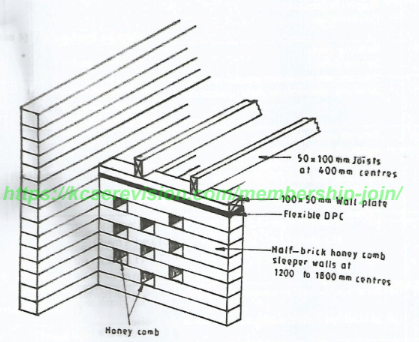
- Oversite concrete
Download Building and construction Paper 1 Questions and Answers - KCSE 2022 Past Papers.
Tap Here to Download for 50/-
Get on WhatsApp for 50/-
Why download?
- ✔ To read offline at any time.
- ✔ To Print at your convenience
- ✔ Share Easily with Friends / Students
